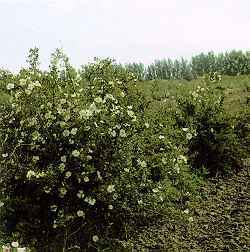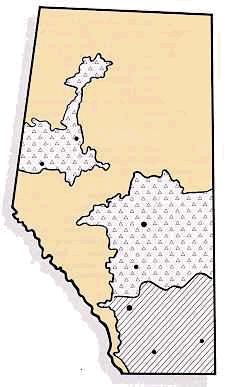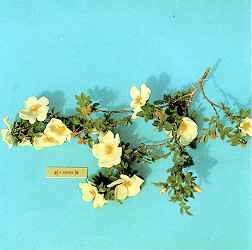| | Plant characteristics | Site preference | Hardiness | Uses | Problems | Disease | Pruning

Scientific Name: Rosa spinossisima var altaica (Willd.) Rehd.
Plant Characteristics
Native in Europe and Western Asia, it was introduced to North America by early settlers.
This low to medium shrub grows up to 1.5 m (4.5 ft) tall. It has medium-fine foliage texture with very densely prickly, spiny branches.
Altai rose is a very long lived shrub, 30+ years. It can grow at a rate of 10 to 45 cm (4 to 18 in.) a year till maturity.
Leaves - Leaflets are 5 to 11, circular to oblong-ovate, 1 to 2 cm (0.4 to 0.8 in.) long, edge serrated, but leaf is smooth.
Flowers - Solitary, but usually very numerous on short branchlets. Usually creamy white but also pink, white or yellow, 2 to 5 cm (1 to 2 in.) across. Flowers in June.
Fruit - Rose hip, black or dark brown found in September.
Site Preference
It does best in rich loam soil, but is adapted to a range of moist well drained through to poorly drained soils. It can withstand flooding during the growing season.
Altai rose has a moderate drought resistance; the plant will survive while exposed to short periods of low moisture.
It is tolerant of some shading, but prefers full sun. Altai rose is not very salt tolerant.
Hardiness
Not completely hardy and is susceptible to freezing and thawing.
.


Uses
It can be planted with poplars in a field shelterbelt. The limited height makes the shelterbelt value of the shrub insignificant. As an ornamental hedge the plant is useful for farmstead beautification. Recommended planting distance in the row is 1 to 1.5 m (3 to 4.5 ft) between plants. The fruit is a rose hip, which is readily eaten by birds. The plant can provide protection for wildlife.
Problems
Altai rose suckers freely which may be considered a nuisance.
Disease
Susceptible to various leaf rusts, leaf spots, powdery mildew, stem cankers, and crown galls.
Pruning
Older hedges can readily be rejuvenated by cutting plants back to ground level. The plant suckers freely, which might be
considered a nuisance, but will make a thick hedge. Roses are sensitive to frost; prune to remove winterkill. Flowers are produced on new wood, so removal of very old wood would encourage flowering. Wide - spreading branches should be removed to keep the shelterbelt in bounds.

Shelterbelts Varieties for Alberta provides information on a number of other trees and shrubs than may be suitable for shelterbelts.
Visit our website directory for the Reforestation Woodlot Listings. |
|